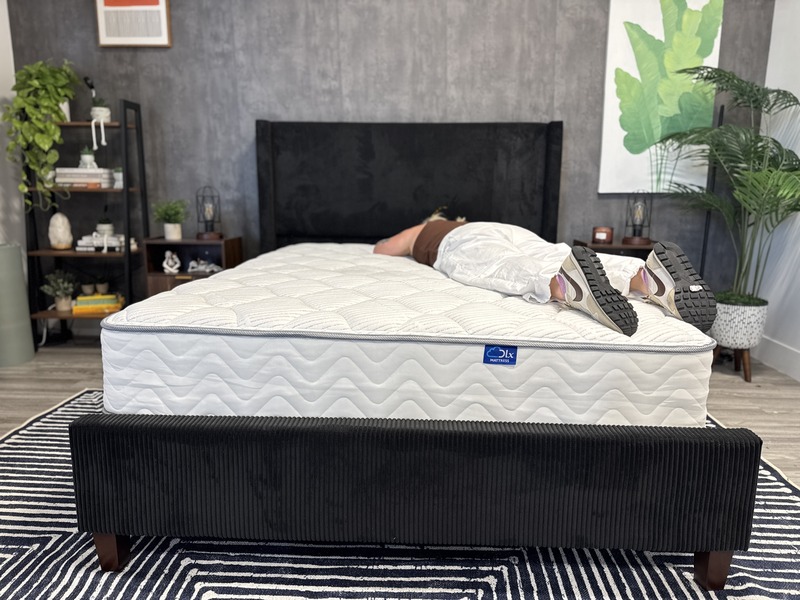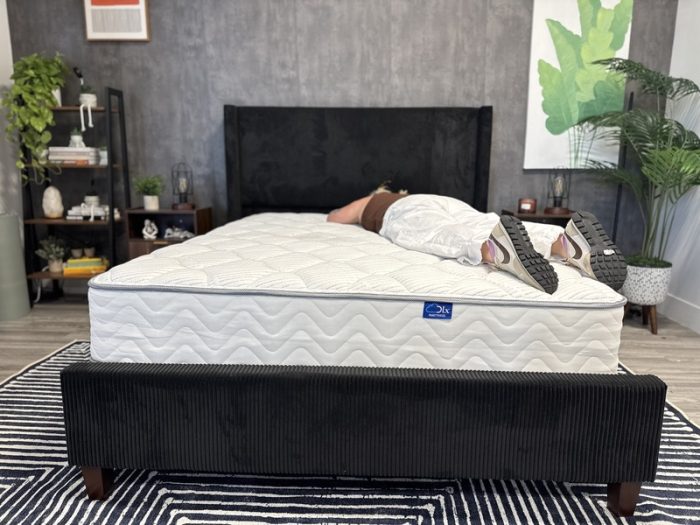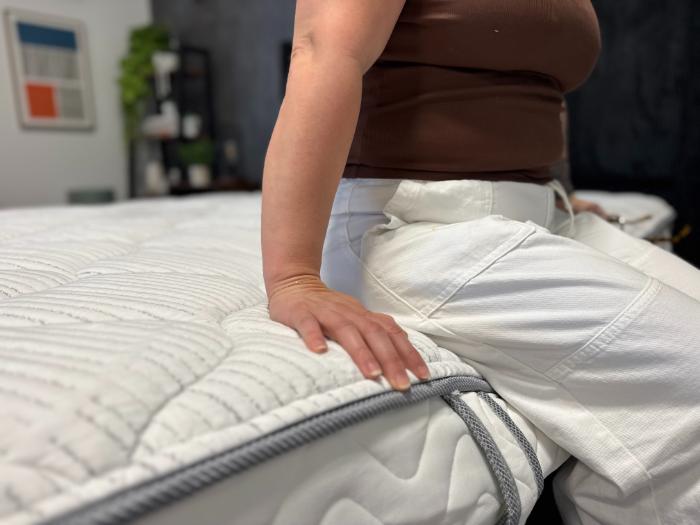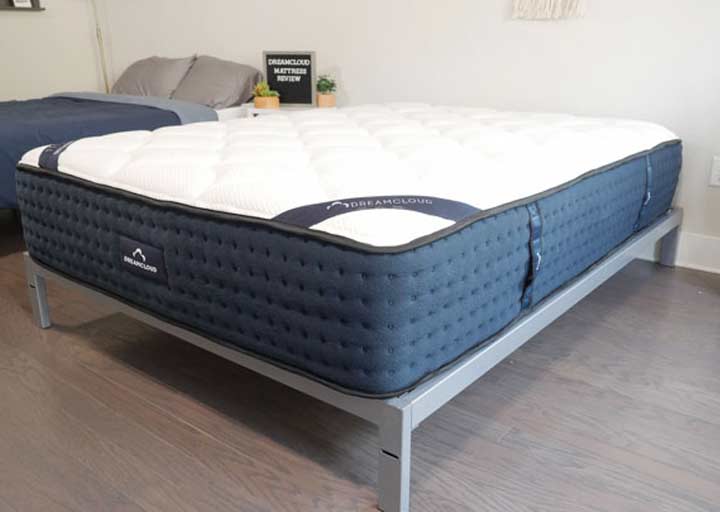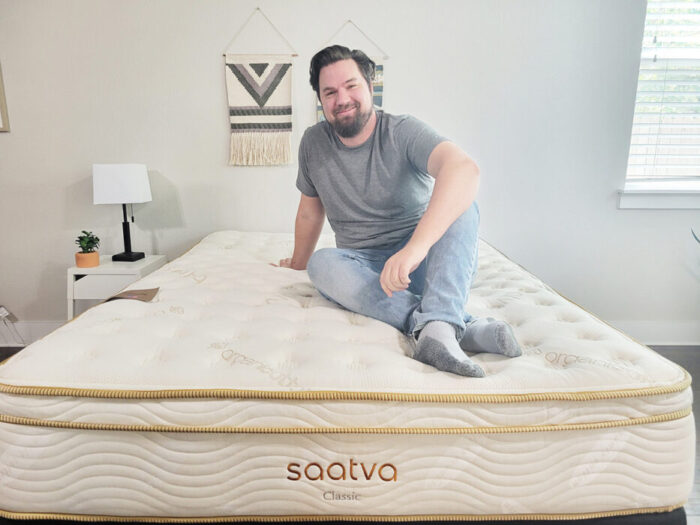You may have heard advice to flip your mattress to make it last longer, but most modern mattresses aren’t designed to support this little hack. The DLX Classic mattress is different. This two-sided mattress has a mirrored construction that should have you sleeping comfortably no matter which side you choose to sleep on.
Our team of sleep experts has been testing and reviewing mattresses (over 500 of them!) for more than seven years. We’ve also worked closely with our chief medical advisor, sleep science specialist and pulmonary physician Dr. Raj Dasgupta, MD, FACP, FCCP, FAASM to add some context to our findings. We’ve helped over 35,000 shoppers find their next new mattress—5,919 in 2024 specifically—so we’re confident that if the DLX Classic bed is for you, you’ll know after reading this review.
This mattress comes in multiple firmness options, and we tested out the Medium. We found this hybrid to be bouncy with a balanced feel, if a touch on the firmer side—a match made in heaven for back sleepers. If it sounds good already, read on to find out everything about this mattress, from its construction to company policies.
The DLX Classic mattress is a hybrid bed with a mirrored design so that you can flip it as needed for durability (or fun!). It comes in three firmness settings, and we found the Medium model to be a great pick for back sleepers. It’s got plenty of bounce, and a more “on-top” feel. It may not be the best pick for some, especially if you’re concerned about motion isolation or looking for something super-soft.
DLX Classic Mattress Performance: My Overall Rating
Our methodology is composed of a volley of tests that evaluate a mattress’s construction and performance, each of which are scored on a scale of 1 to 5, then tallied up for an overall rating on the mattress itself. The DLX Classic mattress came out to a total score of 4.5 out of 5. The bed earned its highest score in response, a perfect 5/5. Trailing not too far behind were pressure relief and edge support, followed by cooling. The bed faltered most in motion isolation, earning 3.3/5.
I Recommend the DLX Classic For…
- Back sleepers – Our testers most enjoyed this bed on their back, so we recommend it for this sleeper type above all.
- Combination sleepers – The coils in this bed contributed to its responsiveness, which makes it easy for combination sleepers to switch positions throughout the night.
- Some side sleepers – Our lightweight and average-weight testers were able to find comfort while lying on their sides, but noted this bed is definitely more for side sleepers who prefer a firmer feel.
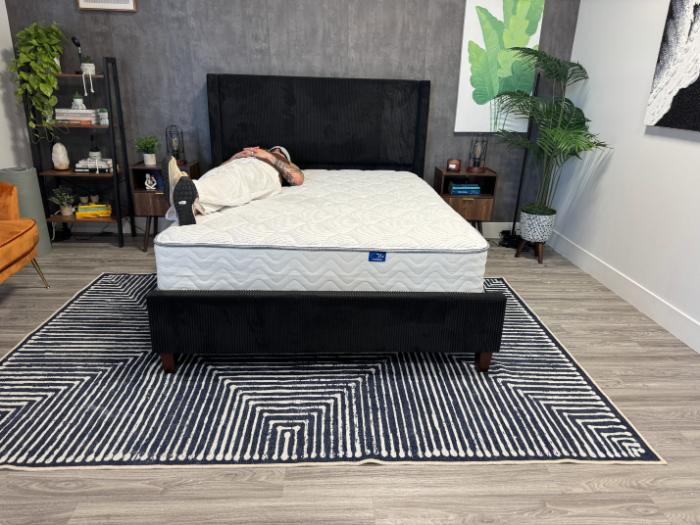
I Don’t Recommend the DLX Classic For…
- Stomach sleepers – Our testers found that this bed’s somewhat firm feel wasn’t enough to keep their hips from sinking in the stomach-sleeping position, which could lead to lower back pain for these folks.
- Light sleepers – The motion isolation test for this bed produced mixed results, so if you’re a light sleeper and share the bed with a restless partner, there’s a chance you’ll feel their movements on the DLX mattress.
- Luxury mattress shoppers – This bed is simple, comfortable, and effective, but it lacks the bells and whistles luxury mattress shoppers might be after.
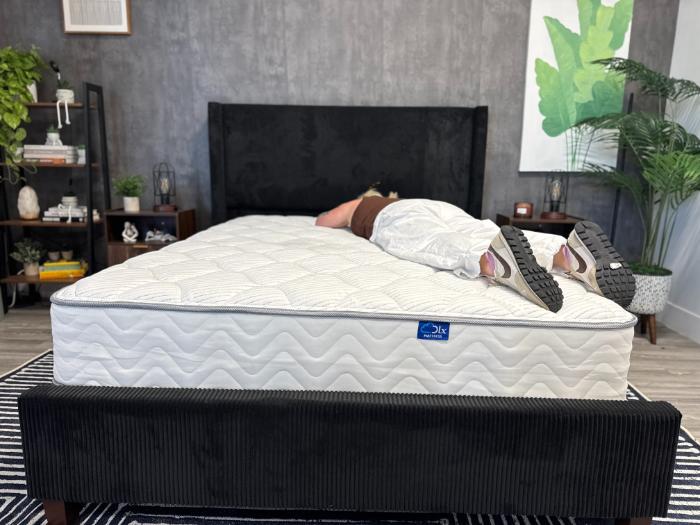
How Firm is the DLX Classic Mattress?

At Mattress Clarity, we rate firmness on a scale of 1 to 10, with 1 being the softest and 10 being the firmest. The DLX Classic mattress comes in three firmness options: Soft, Medium, and Firm. Our testers tested out the mid-range Medium Option, and found that it came in at 7/10, which is just a touch above the industry-standard medium-firm (6.5/10). This slightly firmer feel provides a mix of softness and support that should offer some versatility in terms of what sleeper types it can accommodate.
This mattress is also flippable, which can add to overall durability if you rotate and flip it regularly. Because of its mirrored construction, the bed should feel the same regardless of which side you’re on.
How Well Did the DLX Classic Perform?
When stacked up against the average of all the mattresses we’ve tested, the DLX Classic mostly outperformed or matched what we typically see. Here’s a chart that shows a quick overview of how it scored in our tests, which we’ll dive into more in a second.
| Test | Performance | Average |
| Firmness | 7/10 – Firm | 6.7/10 – Medium-Firm |
| Side Sleeper Comfort | Good | Good |
| Back Sleeper Comfort | Excellent | Good |
| Stomach Sleeper Comfort | Unpleasant | Good |
| Pressure Relief | 4.5/5 | 3.9 |
| Edge Support | 4.6/5 | 4.1 |
| Cooling | 4/5 | 3.8 |
| Motion Isolation | 3.3/5 | 3.9 |
| Response | 5/5 | 4.3 |
| Sinkage Depth | 3.0” | 3.12” |
| Sinkage Rating | Moderate | Moderate |
| Bounce Height | 29” | 17.89” |
| Bounce Rating | High | Moderate |
| Noise | 4/5 | 4.5 |
| Sex | 4.5/5 | 4.3 |
| Trial Period | 4/5 | 4.2 |
| Warranty | 5/5 | 4.6 |
How Does the DLX Classic Feel for Different Body Types and Sleeping Positions?
This mattress is perhaps best suited to those between 130 and 230 pounds seeking a firmer mattress that still offers some pressure relief. Our testers most enjoyed the bed in the back-sleeping position, which we think should work relatively well for all sleeper types. Stomach sleepers, unless they have a smaller frame, are unlikely to get enough comfortable lift on this bed. The bed also has quite a bit of bounce, which should make switching between positions relatively easy.
| Sleeper Weight | Side Sleepers | Back Sleepers | Stomach Sleepers |
| Light (under 130 lbs) | Excellent | Excellent | Good |
| Average (130-230 lbs) | Good | Excellent | Unpleasant |
| Heavy (over 230 lbs) | Good | Good | Unpleasant |
Average-weight Tester – 5’4”, 175 lbs
“I actually really like this on my back. There isn’t a deep contour, but I do notice some contouring in my lower back.” – Sosha Lewis, Certified Sleep Science Coach
Lightweight Tester – 5’5”, 125 lbs
“I like this on my side. My spinal alignment feels fantastic; there is no area that is sinking in too far, and my spine feels straight.” – Riley Otis, Certified Sleep Science Coach
DLX Classic In-Depth Test Results
Pressure Relief
Dr. Raj Dasgupta touted pressure relief as one of the most important components in a mattress when it comes to ensuring comfort. “Taking stress off of sensitive joints and pressure points is key in preventing pain or discomfort,” he explained.
To test this metric, we roll out a specialized mat on the surface of the bed. This mat creates a map of the sleepers body, using thermal technology to record where pressure builds up the most as they sink into the surface. Blue and green means low pressure in an area, while red and yellow means high pressure. Generally, lower pressure is better, and we want to see it evenly distributed across the body.
We use testers that fall into different weight categories to get a more comprehensive understanding of how the mattress will feel for different sleeper types. Riley Otis was our lightweight tester, representing folks who weigh less than 130 pounds.
On her side, Riley plainly said that she liked the mattress, praising the way the bed supported her. “My spinal alignment feels fantastic; there is no area that is sinking in too far and my spine feels straight,” she said. She didn’t feel any notable pressure buildup, but did note that it had a firmer feel to it. “I think this is good for light sleepers who prefer side sleeping with a firmer feel,” she finished before giving the bed a 4.5/5 score for side sleepers’ pressure relief.
When she lay on her back, Riley had an even more positive experience. She called the bed “perfect for back sleeping.” Again, she found the bed supportive, lifting her hips to be in line with her shoulders to keep them from sinking. “I am getting lumbar support and good cushioning in my lower back,” she said. This means the bed should work great for back sleepers with lower back pain. And though she was initially uncertain about the overall feel, the longer she lay there, the more she came to enjoy it. She finished by noting she feels like she is laying more “on top” of the bed, rather than sinking into it, and gave the bed a back sleeping pressure relief score of 5/5.
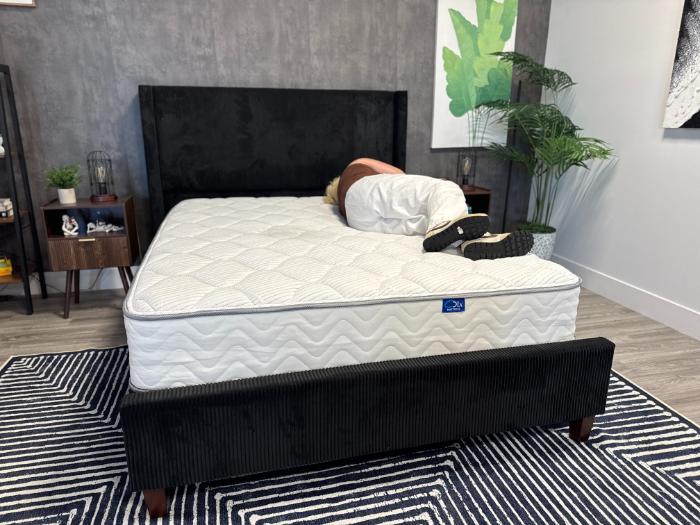
Our average-weight tester was Sosha Lewis, who represents folks from 130 to 230 pounds. On her side, she started out by calling it “not bad!” She noticed a bit more sinkage in her hips, which had the potential to get more uncomfortable over time as pressure builds up, even though she felt fine during the test. Otherwise, she felt relatively supported and her spine seemed in line with her shoulders. “This would be a mattress I would choose more for a guest bedroom but not for my main mattress,” she said, scoring side sleeping pressure relief at a respectable 4/5.
Like Riley, Sosha preferred the mattress on her back. While the bed didn’t hug her body like an all-foam mattress would, she did find some contouring at the gap in her lower back. Her lower half also sunk comfortably into the surface to keep the rest of her body aligned. “My butt feels great, and I don’t know if I have ever said that about a mattress,” she said. Thanks to the overall “really good feeling” she had on this bed, she gave pressure relief while back sleeping a perfect 5/5 score.
Edge Support
A mattress with strong edges will hold up when bearing weight, which should benefit older adults and those with mobility concerns when they get in and out of bed. It’s also important if you like to sleep close to the perimeter of the bed, or with one leg off it, like me. This is why we test edge support in both the sitting and lying down position, gauging how secure we feel in each.
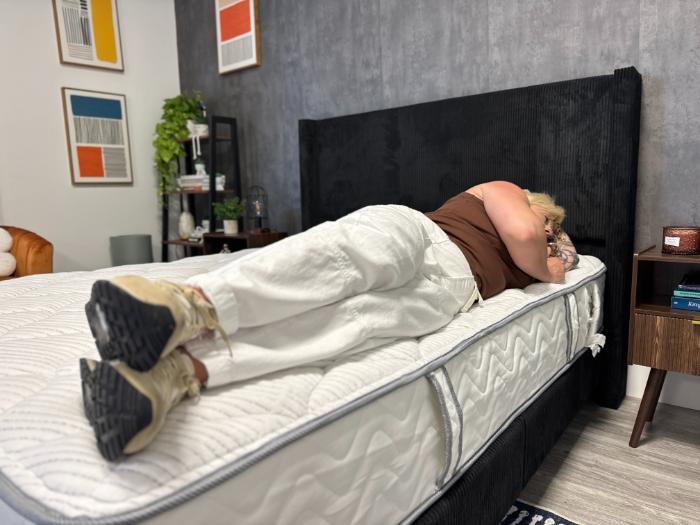
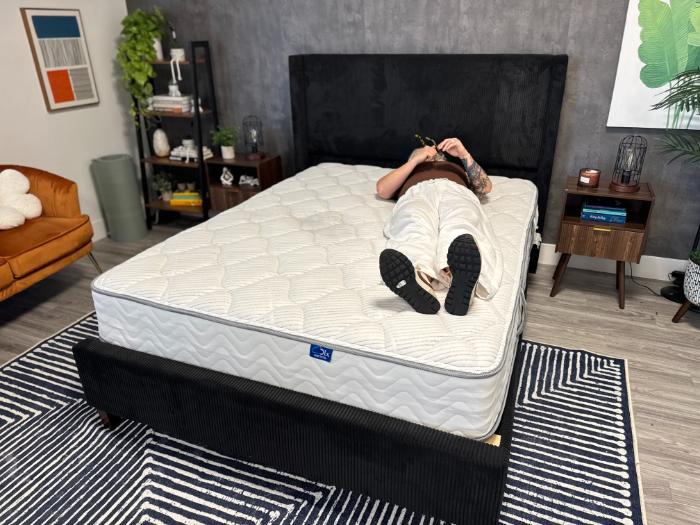
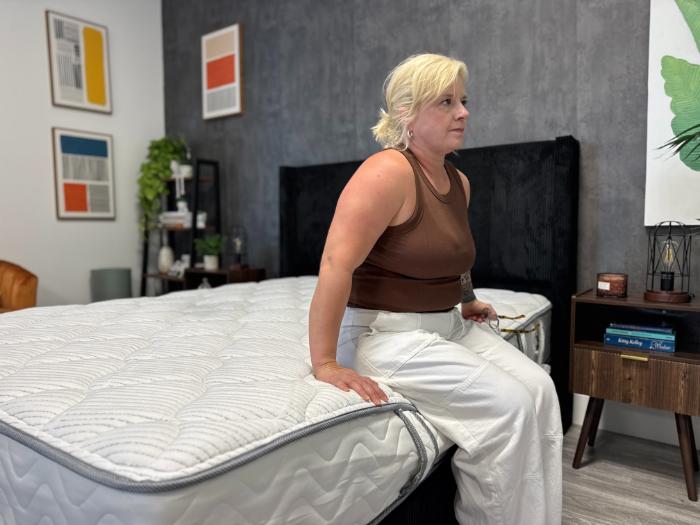
Our tester Sosha noticed that there was “a big difference in the edge support depending on where you’re sitting.” The foot of the bed did not appear to have the same reinforcement as the sides. “It sank down a lot on the foot of the bed, and I did not feel stable,” Sosha said. On the lengthwise edges of the mattress, she found it to be considerably better and felt secure and comfortable getting in and out. She wouldn’t recommend the foot of the bed for activities like tying your shoes.
When she moved to lay down at the perimeter, it was much better and more supportive, regardless of which sleeping position she chose. “I didn’t notice much sinkage at all and wasn’t worried about rolling out,” she explained. She added that this should help couples wanting to spread out, or folks who sleep on the edge like herself. She gave the edge support a final overall rating of 4.6/5.
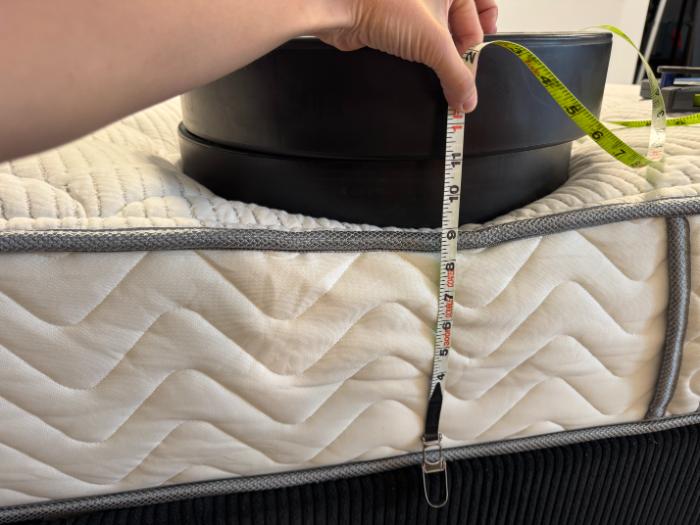
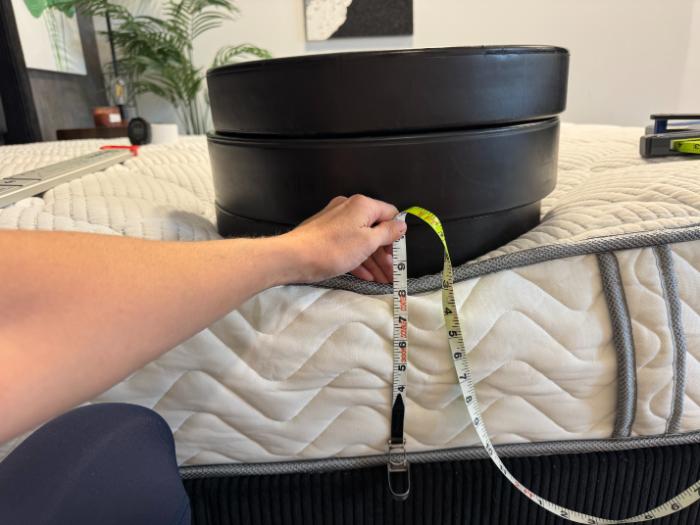
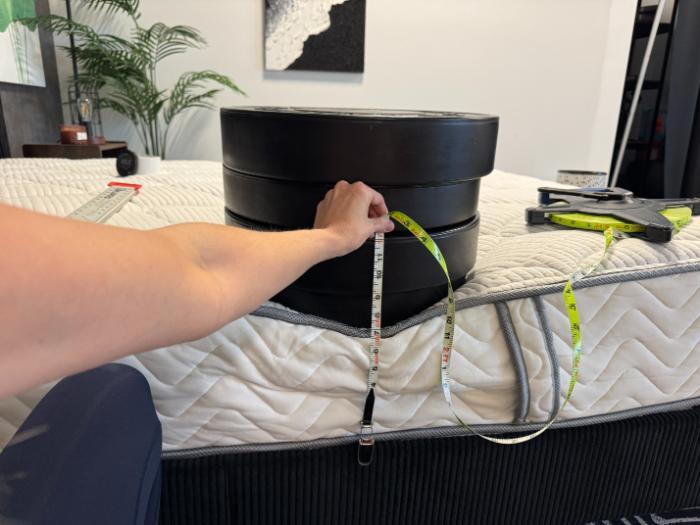
We also test edge support by placing weights right on the edge of the bed and measuring how much sinkage they cause. In this test, too, the DLX Classic excelled. It sank less than average even when the heaviest weights were applied.
According to Dr. Raj Dasgupta, “Alongside high-quality materials, strong edge support is a sign of a durable mattress that’s less likely to sag.” With these results, you should expect the DLX Classic mattress to hold up well into its lifelong warranty.
Cooling
A cooling mattress shouldn’t retain too much heat in order to keep sleepers comfortably cool. That’s why to test cooling, we use a thermal gun to measure how much the surface temperature of a mattress increases when lying on it. We’ll take two temperatures: one before we do any testing, and then another after resting on the mattress for about seven minutes. The temperature increase mostly determines our final score, but we also consider any other experience we had while laying on the bed (i.e., whether it felt cool to the touch).
I’d say that the average temperature increase for a typical bed is around 7 degrees. For the DLX mattress, Sosha first recorded a temperature of 69.9 degrees on the surface, which then rose to 76.1 degrees after a seven-minute nap. This 6.2-degree increase is a sign of relatively good cooling, and Sosha backed it up by noting she didn’t feel any heat building up, but neither did she feel actively cooled. This makes sense, though, since the bed isn’t outfitted with any special cooling features; it’s only the coils that allow air to move through the space between them and the mattress.
With all this in mind, we say the bed should stay pretty temperature-neutral as you rest on it, so most sleepers shouldn’t overheat. Based on these results, the bed earned a final cooling score of 4/5.
Motion Isolation
The words “motion isolation” and “motion transfer” are used to describe whether or not you can feel your partner’s movements from the other side of the bed when you’re sharing it. A bed that isolates motion well will absorb it before it transfers across the surface, disturbing any light sleepers trying to sleep peacefully. To test this metric, we first use a water glass, placing it on one side of the mattress while we move around on the other. How much the water and the glass move is a determinant of how much motion is transferred across the surface.
In the water glass test, Sosha was surprised that the glass toppled over and spilled, a rare occurrence that usually means absolutely horrible motion isolation. “I had gotten pretty close to it when this happened,” she noted, explaining that she thought the contoured shape of the surface made it difficult for the glass to remain upright. “I think there would have been little water disturbance had it been in a larger or wider container,“ she added, but gave this test a low score per our parameters.
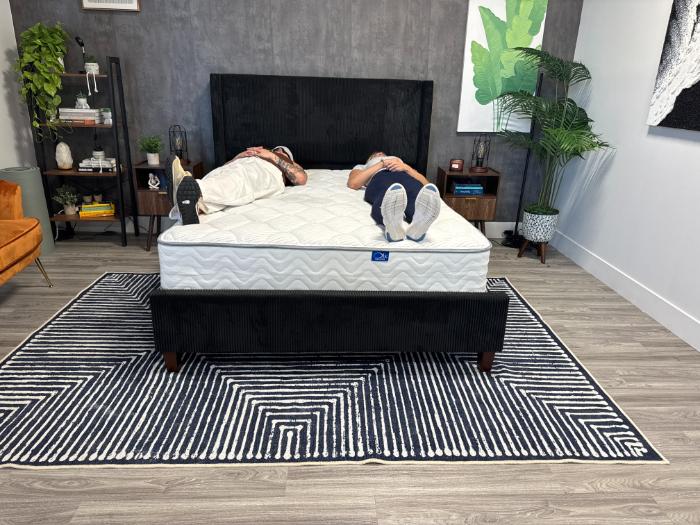
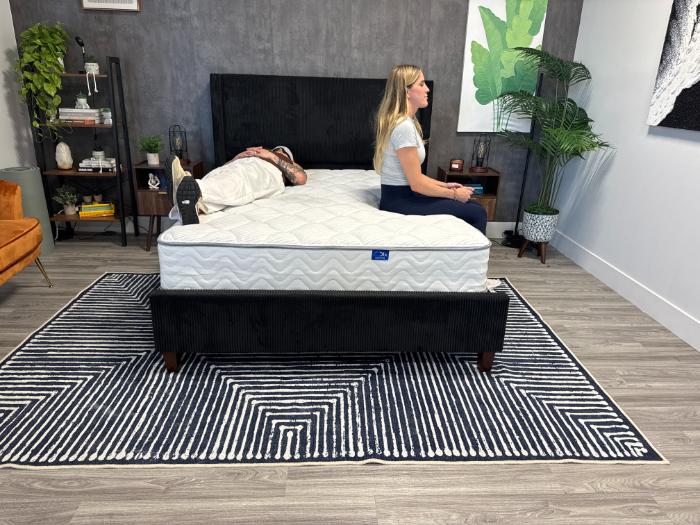
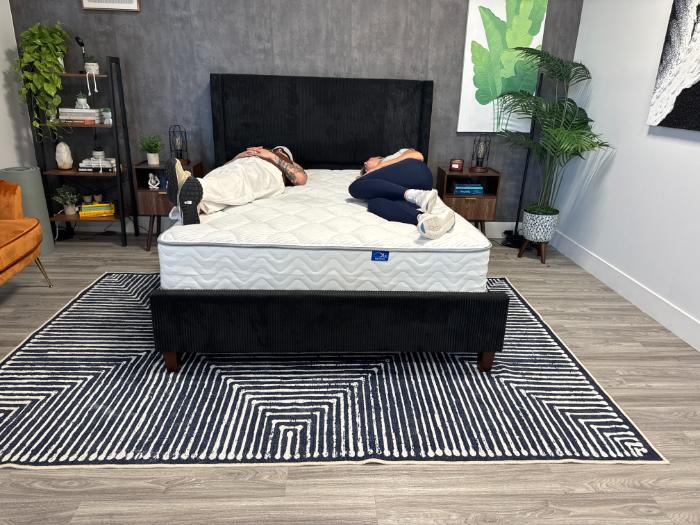
The results were starkly different in our second test. For this one, we have a fellow tester get into bed alongside the first, moving around while they’re blindfolded to emulate how it might feel to be in bed with a restless partner. “I could barely feel my partner getting in and out of bed nor did I feel her moving around,” Sosha said, pushing back against the water test score. Still, with both of these combined, the bed earned an overall motion isolation score of 3.3/5, just barely below average.
While this bed may not be one of the best mattresses for couples, it should still provide some motion absorption for the typical sleeper. But if you’re a super-light sleeper like me, you might want to opt for a bed with a higher score in this category.
Response
A responsive mattress will move with you, bouncing back quickly to retain its shape, making it easy to move about on the surface. This is important for combination sleepers who switch positions, so that’s how we test responsiveness.
As Sosha switched positions, she found that the springs below provided great ease of movement. “It was very easy to turn over on this bed,” she said. “There is a foam top but it doesn’t trap you down in the mattress.” She ultimately rated the bed’s responsiveness at a perfect 5/5. This bodes well for combination sleepers, and those that are sexually active, which we take a closer look at further down.
Sinkage: Moderate
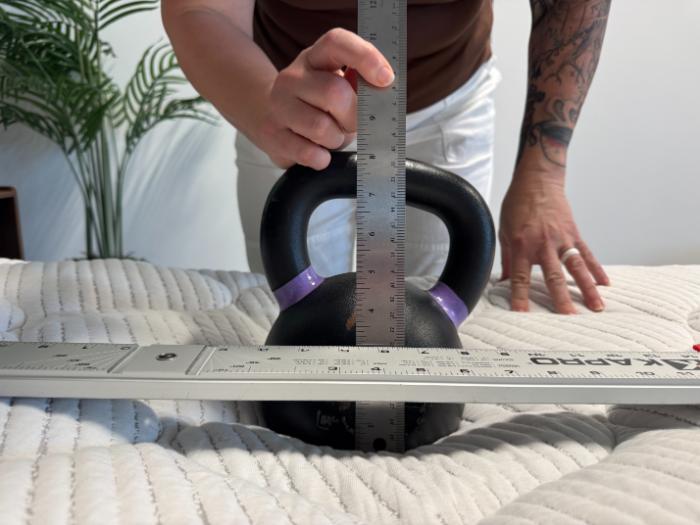
Whether you feel swaddled and hugged by your mattress or like you’re lifted on its surface depends on the amount of sinkage a bed has. The more weight sinks into the mattress, the more cradled you might feel. Think of the typical memory foam feel, how it leaves an impression when you press into it. On the other hand, if you’re like me, you might not want to feel like your bed is swallowing you whole.
The DLX Classic shouldn’t feel like either end of the extreme. When we placed a 44-pound weight on the surface, we measured a dip of 3 inches, which is right around the average of all the beds we’ve tested. So, you should expect a comfortable blend of softness and support.
Bounce: High
We’ve already mentioned responsiveness, which goes hand-in-hand with bounce. A bed that has great response tends to have great bounce. If you’re a combination sleeper, sexually active, or you have a kid that jumps on the bed, you might be wanting a bouncy bed. In order to get a reading for this category, we’ll drop a weighted medicine ball from 6 feet above the bed, measuring how high it bounces up.
For the DLX Classic, we recorded a 29-inch bounce off the bed’s surface. This is well over 18-inch average, further proving our perfect response score. If you’re looking to launch yourself across the surface of your bed, the DLX has you covered.
Noise
Noise is also something to consider if you’re a light sleeper liable to wake up from every creak or puff that your mattress makes. Thankfully, when Sosha moved around on the surface of the mattress, she found it to be “pretty quiet.” Of course, with any hybrid mattress, there’s a chance that the coils may start to squeak with age, so Sosha docked one point for the possibility. The bed earned a final noise score of 4/5.
Sex
A good mattress for sex should excel in three categories: response (for easier movement on the bed), edge support (to make use of the full surface area), and noise (so there isn’t any distraction from the situation at hand). When judging whether a mattress should work for sexually active folks, we take a look at the results we had in each of these categories.
Thankfully, the DLX mattress scored high in each. Its perfect response score should make repositioning easy, while its 4.6/5 edge support score should mean all of the mattress is available for use. The only issue is that the coils might start to creak over time as your mattress ages, but overall, we don’t expect it to be an egregious detraction from your focus and enjoyment. Overall, the DLX Classic mattress should work great for sex.
Adjustable Base Compatibility
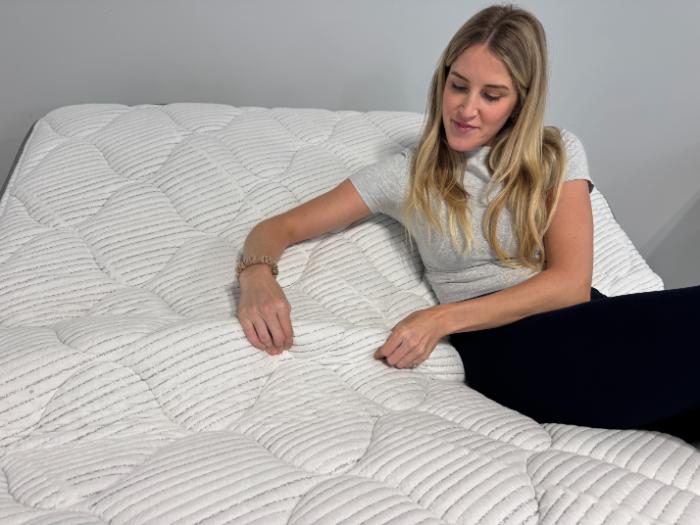
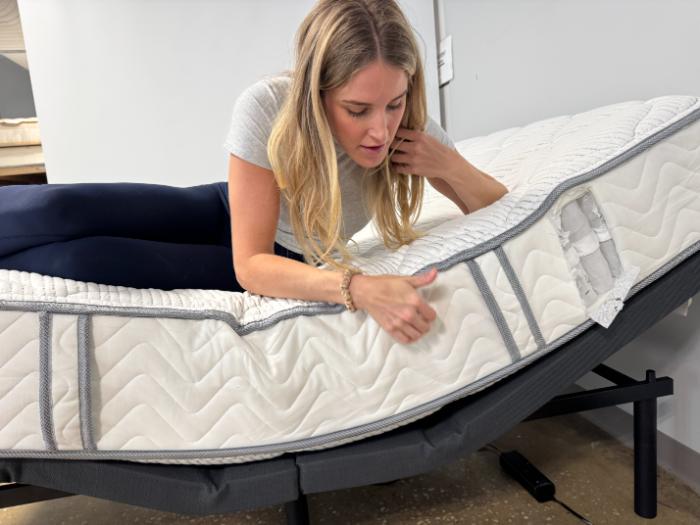
DLX says that their mattresses are adjustable-base compatible, so we put that to the test with one of our own. We did see some gapping at the center when we raised the head of the bed, but this is fairly common, and should lessen with more weight on the bed.
There was also some noticeable scrunching in the cover when both the head and feet were moved. Still, this bed should function relatively well on an adjustable base, and the brand also offers an adjustable base if you’d like to bundle.
DLX Classic Customer Experience Scores
Now that you know how the bed should work, let’s take a look at what else comes alongside it when you purchase it.
Trial Period
Most online mattress brands offer a sleep trial to appease customers who can’t see or touch the bed before they buy it. They can last anywhere from a month to a full year. DLX offers a 120-night trial with their mattress, which is a bit longer than the typical 100-night trial we see. However, it isn’t a full year, so we docked a point and gave the trial a respectable 4/5 score.
Warranty
DLX mattresses come with a limited lifetime warranty. This means from the moment that the bed arrives at your door, it’s backed by the brand’s policy. During the first 10 years of ownership, the brand will replace or repair your mattress if it shows any defects. After that, there is a 50% prorated fee for the same service. This is fairly generous, so we gave the lifetime warranty a score of 4.5/5.
DLX Classic Construction
The DLX mattress is fully made and assembled in the USA, specifically in the brand’s New York factory. This bed’s construction is also unique in that you can flip it over and still have the same level of comfort and support. Let’s dive deeper into what’s inside to see how the bed manages to do so.
Mattress Height
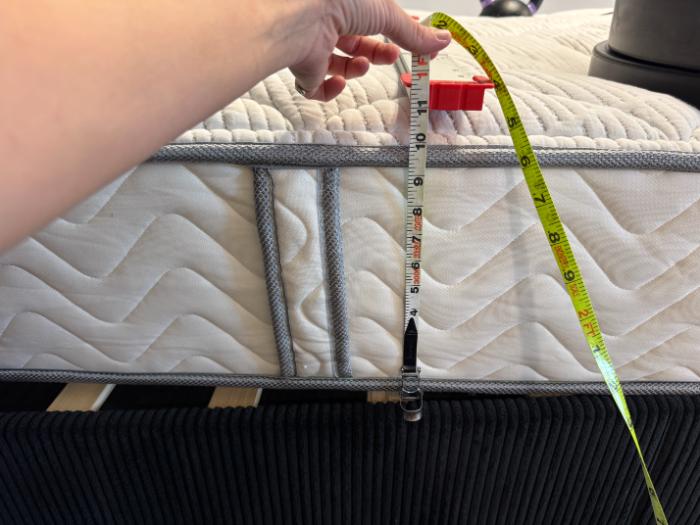
The mattress is about 12 inches thick, which is a fairly common height that should work with most frames.
Materials
As a hybrid mattress, this bed is made with both foam and coils. Since it’s flippable, there are layers of foam on either side of the central coil unit, which we’ll dive into below.
Layers
The DLX Classic is a flippable mattress, meaning it has two sets of foam layers on either side of its innerspring unit. Both sides are swaddled in a breathable cover, which is further insulated by a layer of viscose fibers, creating the pillow top at the surface.
On each side, the first comfort layer is actually two slices of pressure-relieving foam, put together so they can both adapt and contour to the body. The second comfort layer is a “performance foam” designed to bolster support as it transitions into the coil unit. The innerspring unit itself is made up of pocketed coils. At 8 inches thick, it makes up the bulk of the mattress. This construction is mirrored on the other half underneath the coils, accounting for its flippable nature.
How To Try and Buy The DLX Classic Mattress
DLX mattresses are sold exclusively on the DLX website. The brand offers free shipping to 48 states, with fees for Alaska, Hawaii, and Canada. The mattress will arrive in a box for your convenience, which you can set up in-home yourself.
If you’re worried about purchasing a mattress you’ve never seen or touched in-person, I’d recommend taking advantage of the 120-night sleep trial. If after 30 days of trying out the bed, you decide it isn’t for you, you can initiate a refund. After this period, it’ll be backed by the lifetime warranty and what DLX calls a “Lifetime Comfort Assurance Program.” If you end up dissatisfied with your mattress down the line, the brand offers an option to purchase a replacement mattress at 50% of the original price.
DLX Classic Prices & Sizes
| Size | Price |
| Twin | $699.99 |
| Twin XL | $699.99 |
| Full | $899.99 |
| Queen | $999.99 |
| King | $1299.99 |
| California King | $1299.99 |
How The DLX Classic Compares
If you’re still waffling on whether the DLX mattress is for you, see how it compares to some of our other favorite options at Mattress Clarity.
- DreamCloud Original Mattress – Similar Hybrid, Cheaper Price
- Nectar Mattress – Affordable Memory Foam Option
- Saatva Classic – Luxury Upgrade
| Rating |
|
|
|
|
|---|---|---|---|---|
| Firmness |
Medium-firm: 7/10
|
Medium-firm: 6.5/10
|
Medium-firm: 7/10
|
Multiple firmness options
|
| Material |
Hybrid
|
Hybrid
|
Foam
|
Innerspring
|
| Cooling |
—
|
|
—
|
|
| Best For |
Side Sleepers,
Back Sleepers |
Back Sleepers,
Stomach Sleepers, Hot Sleepers |
Side Sleepers,
Back Sleepers, Stomach Sleepers |
Back Sleepers,
Stomach Sleepers, Hot Sleepers |
|
|
DLX Classic vs. DreamCloud Classic Hybrid
Both the DLX Classic and DreamCloud mattresses are hybrids with a firmer-than-average feel, coming in at 7/10 on our scale. Both of these beds were also recommended for back sleepers and earned perfect scores in response.
However, the DLX had a bit more pressure-relieving ability, earning positive feedback from our lightweight and average-weight side sleepers, two categories the DreamCloud was not highly recommended for. The DreamCloud, though, did score much higher in motion isolation, impressing our tester Riley enough to recommend it for couples.
The most obvious difference between the two is price. If it comes down to budget, the DreamCloud outdoes the DLX. A queen-size DreamCloud hybrid costs less than $700 thanks to frequent sales, while a queen-size DLX costs around $1,000.
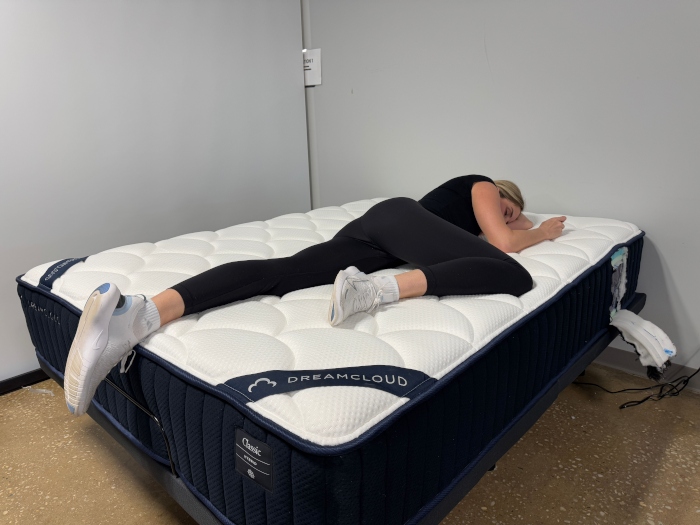
DLX Classic vs. Nectar
If you’re looking for a mattress with a similar feel that isn’t a hybrid, you might want to take a look at Nectar’s Classic Memory Foam mattress. I tested out this bed and found it to be at a 7/10 on the firmness scale, similar to the DLX Classic.
But unlike the DLX Classic, it has better motion isolation because of its all-foam construction, making it a better option for couples. Both beds also did fairly well in terms of pressure relief and worked well for side and back sleepers, but the DLX Classic has more bounce for combination sleepers. I also didn’t mind the Nectar on my stomach, unlike Sosha, who didn’t enjoy the DLX in this position.
Finally, the Nectar mattress is also a more affordable option than the DLX Classic. A queen mattress will only cost you about $700, which is about $300 less than a queen-size DLX. It’s definitely the more affordable of the two, and it also comes with a longer sleep trial at 365 nights.
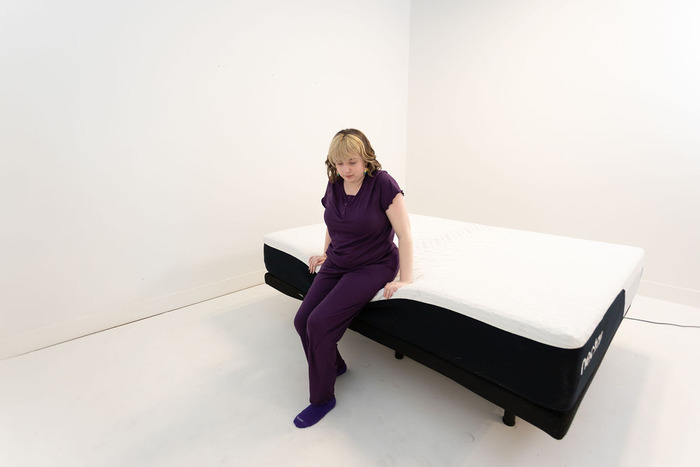
DLX Classic vs. Saatva Classic
Our testers thought that the DLX Classic was certainly “classic,” though it lacked a lot of frills that we tend to see in higher-end mattresses, like supportive zoning in the foams or cooling technology. If you’re looking to level up your sleep, you might want to opt for a luxury mattress like the Saatva Classic. This innerspring mattress, like the DLX, is offered in multiple firmness levels. The mid-range Luxury Firm model also came in at a similar score, at about 7.5/10. Both of these beds are on the firmer side, and both have plenty of bounce.
However, the DLX Classic performed better for couples, able to stop more motion from traveling to the other side of the mattress than the Saatva, which seems only to amplify it. The Saatva Classic also has a more lifted feel that should work stomach sleepers and heavier folks, two sleeper types we wouldn’t recommend trying out the DLX.
The Saatva Classic is certainly more expensive, coming in at over $2,000 for a queen size, whereas the DLX Classic is only $999.

DLX Classic Mattress FAQs
How long does it take for DLX mattresses to ship?
DLX reports that it takes 7 to 14 days upon mattress purchase to ship your mattress, and that it should arrive within two to three weeks. DLX ships for free to the contiguous United States, with fees for Alaska, Hawaii, and Canada.
What is the return policy for DLX mattresses?
DLX offers a 120-night sleep trial, during which you can try out the mattress before committing to it. The brand does not accept actual mattress returns, but will provide a refund upon proof of mattress donation, so long as the customer starts the refund process within the 120-night trial period.






